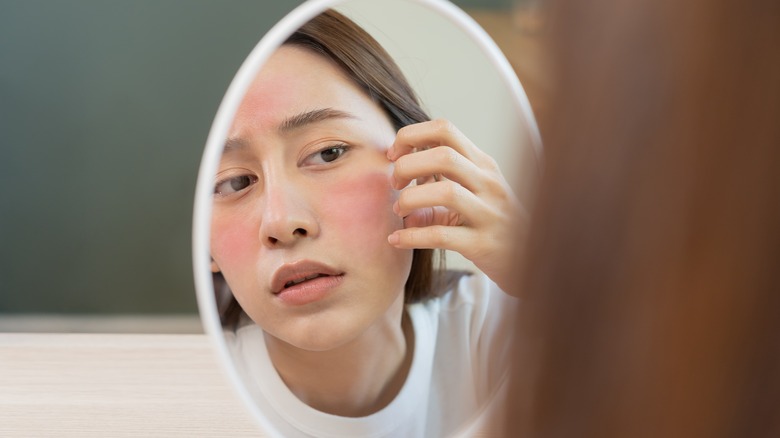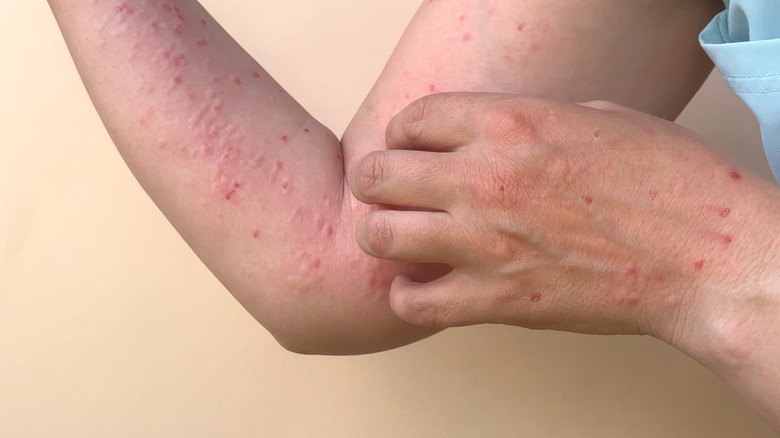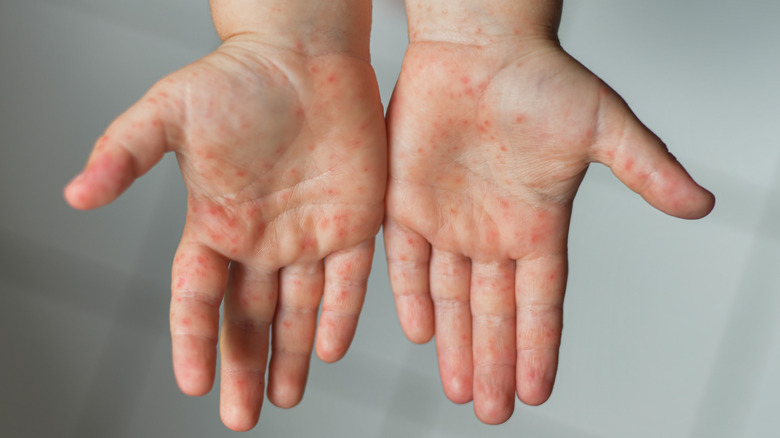The Different Types Of Lupus Explained
An autoimmune disease is diagnosed when the immune system begins to attack the body, particularly organs and tissue, rather than conducting its normal function of protecting the body, per the Mayo Clinic. Lupus is one such autoimmune disease that results in the inflammation of organs, joints, connective tissue, and skin. Lupus is often an elusive condition to diagnose, given the similarities of its symptoms to those of other medical conditions, but knowing about the different types of the condition and how they present within the body can be informative.
The Centers for Disease Control and Prevention (CDC) reports that lupus happens when the body's immune system attacks the organs and tissue it is supposed to safeguard, because it mistakes them for foreign invaders. Many lupus cases are diagnosed in women ages 15 to 44, with an emphasis on childbearing years, but lupus is a lifelong condition with no known cure at this time. Although women are more likely to be diagnosed with lupus, the condition can affect anyone, including children.
There isn't a definitive test for discerning the presence of lupus. Instead, lupus is typically diagnosed after examining a person's full medical history and physical exam results, with an emphasis on hallmark symptoms of lupus like excessive fatigue, joint inflammation, rashes, and unexplained fever. A doctor may also take X-rays and lab tests.
Under the lupus umbrella, there are several subtypes of the condition with their own unique symptoms and side effects. Here's what you should know about the different types of lupus.
Systemic lupus erythematosus (SLE)
The most common form of lupus is called systemic lupus erythematosus, or SLE for short. SLE is chronic and can include flare-ups when symptoms and side effects are exaggerated and more severe. One of the trademark symptoms of SLE is a facial rash colloquially called a butterfly rash since the flat rash often appears with patches on both cheeks that are connected across the nose, thus making a butterfly shape (per MedlinePlus).
According to the Centers for Disease Control and Prevention (CDC), symptoms of SLE can range from mild to severe, and symptoms can vary from person to person since lupus is a condition that has the potential to affect any part of the body. The most frequent symptoms of SLE are fever, fatigue and lethargy, loss of hair, joints that become swollen and subsequently painful, rashes on any portion of skin, and sensitivity to sunlight.
SLE also presents the possibility of kidney complications, which can compound existing symptoms of lupus. Additional concerns include damage to blood vessels, called vasculitis, and a condition called calcinosis which occurs when deposits of calcium form beneath the skin (via MedlinePlus). Some people may also develop heart problems. If these concerns arise, always consult with your doctor.
Lupus of the skin
When it comes to lupus of the skin, the diagnosis is divided into three additional subtypes, per Johns Hopkins Medicine. The three types of lupus of the skin are acute cutaneous lupus, subacute cutaneous lupus erythematosus, and discoid lupus erythematosus (DLE) which is also referred to as chronic cutaneous lupus erythematosus.
All three types of lupus of the skin present with skin lesions, though each subtype has its own patterns on the skin. Lupus of the skin is frequently diagnosed through a biopsy of skin tissue to confirm the subtype.
Skin lesions, rashes, swelling, and thick, scaly patches of skin tissue can appear, according to the American Academy of Dermatology Association. Common areas for skin symptoms include the neck, ears, arms, hands, upper legs, scalp, and the face, including on the lips. Lupus of the skin can also develop on the chest, back, and buttocks. Sores can appear inside the mouth, vagina, or nose.
A dermatologist can treat a lupus rash through the use of steroid creams applied directly to the skin, and through the use of antimalarial medications (via Cleveland Clinic). To prevent a lupus rash from occurring, it's recommended to protect yourself from UV light. For example, tanning beds and excessive amounts of time in the sun should be avoided. Due to light sensitivity, using low-intensity light bulbs for indoor light can lower rash risk.
Neonatal lupus erythematosus
Like its name indicates, neonatal lupus erythematosus affects newborns. It develops after a mother passes along Ro/La autoantibodies during pregnancy (via DermNet). It affects up to 15% of children born to mothers who are positive for certain antibodies, which in the medical world are called anti-SSA(Ro), anti-SSB(La), and anti-U1RNP.
Even if a baby isn't born with symptoms of neonatal lupus erythematosus, the condition can still be present, and symptoms like skin rash will likely appear following the infant's first exposure to sunlight. Sensitivity to light, particularly sunlight, is a common symptom of this type of lupus that affects newborns.
After light exposure, a rash will often appear. Neonatal lupus erythematosus is commonly associated with a raccoon eye rash that appears across a baby's facial skin around the eyes. Alternatively, the rash may resemble a SLE rash, or affect the trunk, arms, or legs (per National Organization for Rare Disorders).
Johns Hopkins Medicine reports that infants born with neonatal lupus erythematosus are at risk for additional complications involving their livers and hearts. They are also susceptible to having blood cell counts that are lower than normal. The condition is rare.
Childhood lupus
Childhood lupus, also known as pediatric lupus, is diagnosed in children who present with the symptoms of systemic lupus erythematosus (SLE), according to Children's Hospital of Philadelphia. Adolescents around the age of 15 or older make up the majority of childhood lupus cases, though the condition can affect younger children.
Just like lupus in adults, pediatric lupus comes with a variety of symptoms unique to each child, and those symptoms can go through periods of flares when they are especially intense and then go into remission before eventually flaring up again. Children diagnosed with lupus may also experience kidney complications, including kidney failure, which can lower the survival rate of pediatric lupus patients.
Cleveland Clinic reports that cases of pediatric lupus spike in number around the age of 12, which may be attributed to the hormones that come with puberty. Coping with the diagnosis and symptoms of the autoimmune condition can be difficult for children, so mental health counseling is often part of a child's treatment plan.
Other specialists who form a team of medical professionals who collaborate to treat cases of childhood lupus include physical therapists, pediatric rheumatologists, and a variety of trained nurses. Since there isn't a cure for lupus, which can be a complex concept for children to comprehend, the psychological well-being of children diagnosed with lupus is prioritized alongside their physical medical treatment.
Drug-induced lupus erythematosus
Unlike other types of lupus that are often caused by unknown triggers, drug-induced lupus erythematosus is caused by a handful of medications that result in symptoms of lupus as side effects, says Johns Hopkins Medicine. There are up to 20,000 new cases of drug-induced lupus diagnosed in Americans each year (via Healthline). While SLE is frequently seen in women of childbearing ages, and neonatal lupus and pediatric lupus affect infants and children, respectively, drug-induced lupus is often seen in patients between the ages of 50 and 70.
Some medications that are known to cause symptoms of lupus are isoniazid, which is a medication for the treatment of tuberculosis; minocycline, used in the treatment of acne; procainamide that is occasionally employed to correct irregular heart rhythms; and hydralazine, which is a hypertension medication that is now only occasionally prescribed. Certain medications used in the treatment of arthritis have also been found to cause drug-induced lupus erythematosus.
If you have concerns about the potential side effects of medications, or if you experience uncomfortable symptoms while taking new medications, make an appointment to speak with your healthcare provider. Unlike other types of lupus that are chronic and for which no cures exist, drug-induced lupus erythematosus can be reversed if the use of the medication causing the symptoms is ceased, and you work with your doctor to find a new medication that suits your needs without causing intolerable side effects.






